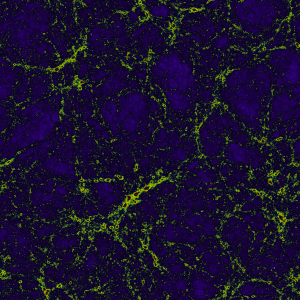The formation and evolution of galaxies is intimately linked to the growth and formation of the cosmic web in the Universe via gravitational forces. Hence, to get a full understanding of how galaxies form and evolve we need to study them in tandem with the large scale structure. This requires computer simulations of representative volumes of the Universe (i.e. N-body simulations; see image below for an example), which allow us to reconstruct the growth of structures in the Universe, combined with semi-analytic physical models of how galaxies form and evolve. This technique provides an ideal suite of simulated galaxy populations encompassing a large dynamic range of galaxy environments, typically used to connect the physics of galaxy formation with what we observe from the distant to the nearby Universe. Hence, this approach is critical for the planning of large galaxy surveys as well as aiding the interpretation of observations. Several large galaxy surveys make extensive use of the tools developed by our group including the Square Kilometer Array (SKA) pathfinders and next-generation photometric and spectroscopic galaxy surveys (DEVILS, WAVES).
The prospective student can get involved in various aspects of this broad research area, including:
1) Environmental effects on galaxy evolution throughout cosmic time, including galaxy-galaxy interactions and galaxy-group interactions.
2) The baryon cycle in galaxies: how gas accretion onto galaxies, star formation, stellar and black hole feedback interplay with each other.
3) The galaxy-halo connection: how galaxy properties are linked to their dark matter halo properties.
4) Chemical evolution of galaxies and the interplay with their star formation and interaction history.
5) Exploitation of advanced statistical tools to explore the parameter space of galaxy formation.
6) Extension of model by adding new/better physical processes, and creating synthetic outputs covering new wavelength ranges, including radio continuum and line emission.

Visualization of the large scale structure of the one our SURFS simulations (Credit: Chris Power, Pascal Elahi, Claudia Lagos and Aaron Robotham)
